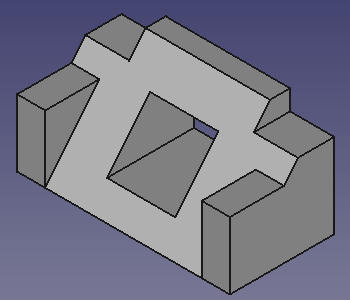Basic Part Design Tutorial 019
| Topic |
|---|
| Modeling |
| Level |
| Beginner |
| Time to complete |
| Less than an hour |
| Authors |
| Carlo Dormeletti (onekk) |
| FreeCAD version |
| 0.19 or higher |
| Example files |
| [] |
| See also |
| None |
This tutorial introduces the new user to some of the tools and techniques used in the PartDesign Workbench. This tutorial is not a complete and comprehensive guide to the Part Design Workbench and many of the tools and capabilities are not covered. This tutorial will take user through the steps needed to model the part shown in the image below using sketches.
Author Note: This tutorial is work in progress, in this state it is tested only with FreeCAD version 0.20.1 for Linux. Screenshots are made for 0.20.1 too, but it should work without big problems even on 0.19.
As soon I find someone to review it for 0.19 I will made appropriate remarks if necessary for v0.19
Before You Begin
The Task
In this tutorial, you will be using the Part Design Workbench to create a 3D solid model of the part shown in the Drawing below. All of the necessary dimensions to complete this task are given. You will start by creating a core shape from a base Sketch and then build on that shape, adding what is known as Features. These features will either add material to, or remove material from the solid by use of additional sketches and accompanying feature operations. This Tutorial will not use every feature and tool available within the Part Design Workbench, but should use enough to give the user of this tutorial a basic foundation upon which to build their knowledge and skills.
The Part
Constructing The Part
Startup
First begin by making sure you are in the Part Design Workbench. Once there, you will want to create a new document if you have not done so already. It is a good habit to save your work often, so before anything else save the new document, giving it any name you might like.
All work in Part Design begins with a Body. Then we will build the solid inside the body by starting with a sketch.
Click on Create new body to create and activate a new Body Container. Note: this step can be omitted. When creating a sketch, if no existing Body is found, a new one will be automatically created and activated.
Sketch
You will create a base skecth, this is to create the base shape that is a rectangle, but you will use named constraints, that could be reused to make the model parametric.
This way the constraints, hold a dimension that could be reused across the model, as example if you want the model be 55mm wide and not 53mm as in the technical drawing, it is simply a matter to edit base sketch and modify the length of the appropriate named constraint.
Create Sketch
- Click on
Create new sketch. This will create the sketch within the just created body. It will be named Sketch
- You need to define where the sketch will be attached. We will attach it to a plane from the Body´s Origin.
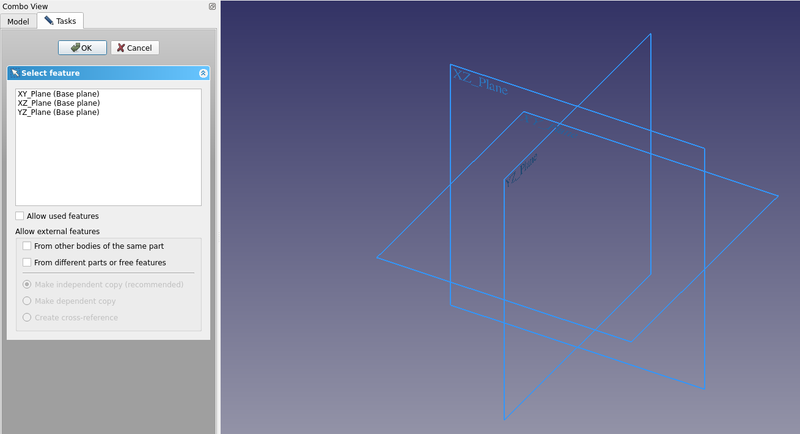
- In the Tasks tab from the Combo view, select XY_Plane in the list and press OK
Note: it's possible that the OK button may not be visible if the side panel is not wide enough. You can make it wider by dragging its right border. Place your mouse pointer over the border; when the pointer changes to a two-way arrow, press and hold the left mouse button and drag.
Once you click OK, FreeCAD automatically switches to the Sketcher workbench and opens the sketch in editing mode:
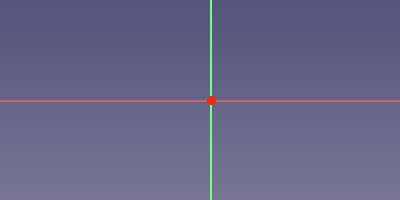
Starting state of Sketcher
Create the rectangle
Click on Rectangle tool and start creating a rectangle:
Some notes:
- Create the rectangle roughle centered on Y axis but not with upper side laying on the X axis, if not Solver will apply a constraint that will create some problem later.
- It is not important at this step to make exact dimensions, we will set them using constraints later.
- When finished with rectangle creation, press ESC, if not FreeCAD will remain in "rectangle creation" mode indicated by this cursor appearance
 and you will start creation of another rectangle.
and you will start creation of another rectangle.
Applying constraints
| Fig: HS1 | Fig: HS2 | Fig: HS3 |
|---|---|---|
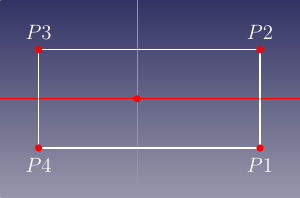 |
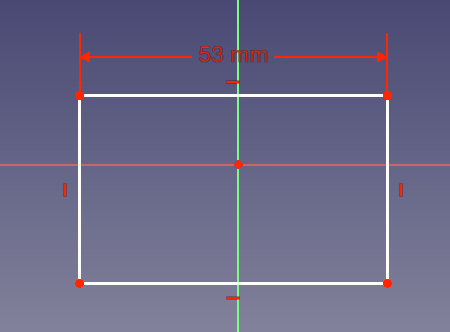 |
Fig: HS3 |
Horizontal constraint
Assign now horizontal distance constraint this way:
- Select the upper line like in the Fig: HS1.
- Use the button
horizontal distance constraint this will make two things:
- A dimension will appear between extreme points of the line selected. This dimension is the actual dimension.
- A dialog like the one below will appear.
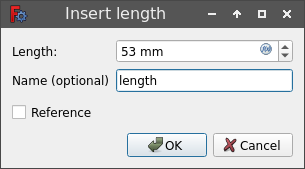
In this dialog you could set an exact Length and optionally assign a Name to this length.
- Assign a Length = 53mm and Name = length and press OK.
You will be presented with an image that will resemble Fig: HS2
Symmetrical constraint
You have to center the rectangle, by design the center of the X axis is chosen to do so:
- Select points like in Fig: HS3.
- Use
Symmetric tool and apply the symmetry.
You will end with something that resemble Fig: V1 below.
Vertical constraint
| Fig: V1 | Fig: V2 | Fig: V3 |
|---|---|---|
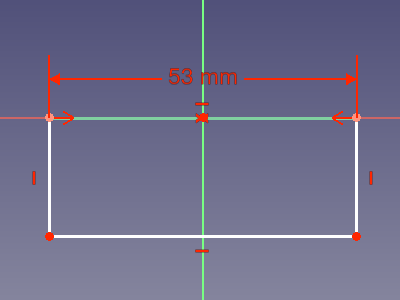 |
Fig: V2 | 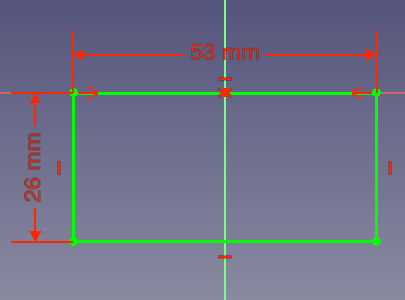
|
Assign now a vertical distance constraint, the procedure is similar to the former.
- Select the vertical line like in the image Fig: V2
- Using the button
vertical distance constraint and assign Length = 26 mm and Name = width.
Once clicked on OK you will have the result shown in Fig: V3.
Side Profile
You will create a new sketch that is holding the side profile.
Create the Sketch001
Click on Create new sketch. This will create the sketch within the just created body, and FreeCAD will assign the name of Sketch001.
When choosing the plane you will select YZ_Plane in the list and press OK:
Use the Polyline tool and make a shape roughly like that in Fig: SP1; Exact shape is not important as like in the first sketch you will assign proper constraints later.
If you had Auto constraints on, some of these constraints will have been applied automatically, if not, do the following. But first make sure that you have exited the Polyline tool by right-clicking or pressing ESC twice; the mouse cursor should turn back from a cross-hair to the standard arrow cursor. (Don't press ESC a third time or you will exit the sketch editing mode; if this happens, click on the Model tab, then double-click the Sketch element in the tree, or right-click and select Edit sketch in the contextual menu.)
NOTE: if the sketcher solver detects a redundant constraint it will turn the sketch orange in colour, and before further constraints are added, the redundant constraint should be removed. (The redundant constraint is shown in the Task view, click on the blue reference and press delete.)
| Fig: SP1 | Fig: SP2 | Fig: SP3 |
|---|---|---|
| Fig: SP1 | Fig: SP2 | Fig: SP3 |
| Fig: SP4 |
|---|
| Fig: SP4 |
Applying Constraints
From Fig: SP1 you will see that FreeCAD has already applied some constraints:
- Top horizontal line has a
Horizontal Constraint applied.
- Right point of the top line has a
Point On Object Constraint applied.
- Left point of bottom horizontal line has another
Point On Object Constraint applied.
Note: when using "named constraints" you have to refer to the "Name" property, but names shown here may vary due to the way the example file is done (It was made using Part Design Scripting), refer to the names you have in your design
- Select points as in Fig: SP2 above and apply a
horizontal distance constraint and assign Length = 5 mm
- Select points as in Fig: SP3 above and apply a
vertical distance constraint and assign Length = 26 mm
- Select points as in Fig: SP4 above and apply a
horizontal distance constraint for the value you will use a "Named constraints" using Expressions to do so you have to press the little button on the dimensions
, and you are presented with a new dialog window named Formula editor that contains an input field and a Result: label, similar to the image below:

Expression dialog
- if you start typing in the cell, you will be presented with some autocompletions, base on the "Name" of the sketch, in the example is
<<Sketch>>.
Select the right one for your design; Field should have autocompletion so if you select an element you will be presented with<<Sketch>>., note the point after the "element name". - Next step is to choose the correct things, you have have named a Constraint "width", bit it is not working so flawlessy you had to write the word
Constraints.with the point, ans sadly there is no autocomplete (yet) - Third and last step is to add the "length" name so the cell will read
<<Sketch>>.Constraints.widthif all is good you should see in the cell Result: the correct value as in figure below:

Espression result good
Note the absence of "red words" and the correct value in the Result field
- if you start typing in the cell, you will be presented with some autocompletions, base on the "Name" of the sketch, in the example is
Finalizing the Sketch
At this point you should have a fully constrained sketch as indicated by it changing color and the message shown in the Combo View. It should now look just like the image below:
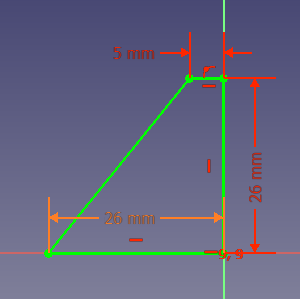
Note the differences in color between distance constraints assigned using expressions and those assigned specifying a length.
Now in the Tasks tab, click on the Close button to leave the sketch edit mode
Making the Pad
Select Pad from the toolbar or from the Part Design menu.
This will give you a Pad dialog in the Task View.
Using that dialog, set it's values accordingly to the following directions:
- Using Type pulldown menu, select Dimension.
- For Length we use again an Expression but this time you will enter
<<Sketch>>.Constraints.lengthin the field. - Select Symmetric to plane checkbox.
Once that is done you will have a solid as shown in the image below:
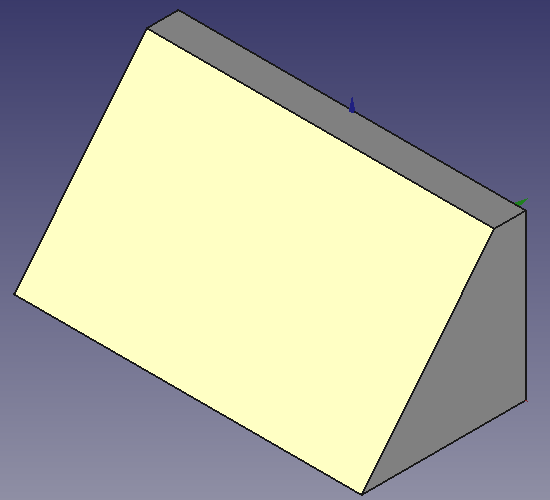
Features with pocket
- Click on the New sketch icon in the toolbar or from the Part Design menu. This will create a sketch named Sketch002
- Now select
Rectangle tool, and create a rectangle, do not create it using near the axis, to avoid automatic constraints that will make difficult to move it in the correct position using External geometry tool.
Apply these constraints:- Select one of the horizontal lines apply a horizontal distance constraint and a value of 5 mm.
- Select one of the vertical lines and give it a vertical distance constraint and a value of 11 mm.
You should have something similar to the figure below:
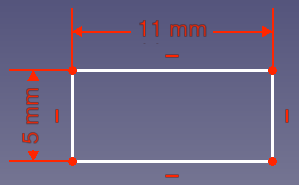
Sketch_2 unfinished
- Click the Close button at the top of the Tasks tab in the Combo View window.
Adding external geometries constraints
Adding an External geometry need that you have sketches on which we are "attaching" our geometry visible.
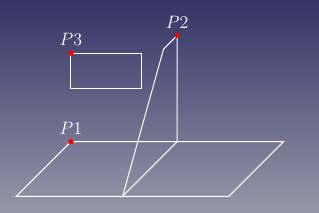 |
To do so in the Treeview select Sketch and Sketch001 and make both visible using the spacebar, if everything is ok you will have something that resemble the image in Fig:1 below:
Double click on the Sketch_2 to activate again edit mode.
- Select
External geometry tool.
Once that is done, click the Close button at the top of the Tasks tab in the Combo View window,
Pockets
Select Pocket tool from the toolbar or Part Design menu. Using this tool is the opposite of the Pad tool. As the Pad tool adds material to the part, the Pocket tool removes material from the part. Both operations are called features. In this Pocket operation we want to select Through all from the type pulldown-menu and then click the OK button.
For the next operation, make sure that “Pocket” is selected in the Model tree view and once done, click on the Mirror feature on the toolbar or from the Part Design menu. In the Mirror dialog in the Combo View, select Horizontal sketch axis from the Plane pulldown menu. Then click OK. The Mirror feature works in this way because the base feature of our model was Padded both ways from the horizontal plane in the first operation with the base sketch. If all has gone well, you should now have a part that looks like the image below after you orbit it around to the front.
Features with pad and external geometry
After taking a look, orbit back around and once again select the back face of the part and select that face to map the next sketch to.
Select New sketch and make a new rectangle in the manner similar to what is shown below in the next image. Then proceed to add dimensional constraints to the rectangle.
- Select a horizontal line and apply a horizontal distance constraint with a value of 16.7.
- Select a vertical line and apply a vertical distance constraint of 7 mm
- Using the External geometry tool, select the upper left vertex of the part face.
Now selecting the upper left vertex of the rectangle and the external geometry point, click on the coincident constraint to fully constrain the sketch.
Close the Sketcher.
Next we will click on the Pad feature and in the Pad dialog in the Combo View we want a length of 26 mm leaving the type as Dimension and then placing a check on the Reversed checkbox. Using the Reversed checkbox will cause the Pad to go into the part instead of away from the part. This operation provides with the following result.
Once again use the Mirror feature to get the second pad. First ensure that created Pad is selected in the tree view, then click on Mirror in the toolbar or select it from the Part Design menu. We will repeat the operation we did for Pocket above and select Horizontal sketch axis from the Plane pulldown menu.
Feature with pocket and external geometry
At this point orbiting the part around to the front, we can see that our part is now starting to look like the part in the dimensioned drawing at the beginning of this tutorial. Once you have the view of the front, click on the sloped face with your mouse to select the face we will use for the next sketch.
Here we will use the Rectangle tool and place a rectangle in our sketch and once having done so, apply the following constraints.
- Select a horizontal line and a vertical line, and after both are selected, click on the Equals constraint.
- Select either a horizontal or vertical line and apply a corresponding horizontal or vertical distance constraint with a value of 17 mm
- Using the External geometry tool, select the top right vertex as shown in the image below.
Now using the dimensions from the drawing, apply the following constraints.
- Select the external geometry point and the upper right vertex of the now square sketch and apply a horizontal distance constraint of 7 mm
- Select the external geometry point and the upper right vertex of the now square sketch and apply a vertical distance constraint of 11 mm
The result should be as follows.
At this point if we were to simply Pocket this sketch, the resulting hole would be perpendicular to the sloped face that it is mapped to, and this is not what we want.
We want the hole to be perpendicular to the back face, but it's projected dimensions are not the 17 mm x 17 mm dimensions that are given in the drawing. Now we could do the math and calculate the dimensions needed, or we can use the tools provided in FreeCAD to make that projection for us.
To create pocket which has the sloped rectangle as it´s outlet, we draw a new rectangle on the rear side, using the projection of the sloped rectangle as an external reference.
Orbit the Solid around to see the rear face of the part once again and select the back face to map the final sketch to.
Select New Sketch from the toolbar or Part Design menu. Now in sketch edit mode, we do not see the sketched rectangle on the slope. To make it selectable , we switch the combo view to model tab and select the last sketch made (Sketch003) on the sloped plane. Then using the spacebar, make it visible. Next, select the mirror feature above (mirrored001) and again using the spacebar, hide it. Then you should see the sloped rectangle inside the 3D View. You may continue to work with the model tab visible, or switch back to tasks tab. Using the
External geometry tool, select the upper and lower horizontal edges of the sloped rectangle. Then, add a new rectangle to the sketch using the
Rectangle tool.
- Select the upper left vertex of the new rectangle and the upper left point of the external geometry and click on the coincident constraint.
- Click on the lower right vertex of the new rectangle and the lower right point of the external geometry and click on the coincident constraint.
And we should end up with this.
For the final step in this tutorial, close the sketcher window using close or finish editing from the context menu of sketch004 and then select the Pocket feature from the toolbar or from the Part Design menu. From the Type pulldown select Through all and click the OK button.
At this point, you will see some lines which come from intersecting features. In this case the side block intersects with the base profile letting it appear as a triangular block above the profile (i.e., there is an extra line visible in the above picture on the right face of the model). To remove these lines, you can either switch on "refine shape" in your Part Design Settings or, to save some processing speed and still have these lines while constructing, individually switch it on at each feature. The Setting on feature level can be done in the "data" tab of the feature. Set the refine property to TRUE for the pocket feature Pocket001 to invoke refining.
This tutorial and your model are complete.
Additional Resources
- Structure tools: Part, Group
- Helper tools: Create body, Create sketch, Edit sketch, Map sketch to face
- Modeling tools
- Datum tools: Create a datum point, Create a datum line, Create a datum plane, Create a local coordinate system, Create a shape binder, Create a sub-object(s) shape binder, Create a clone
- Additive tools: Pad, Revolution, Additive loft, Additive pipe, Additive helix, Additive box, Additive cylinder, Additive sphere, Additive cone, Additive ellipsoid, Additive torus, Additive prism, Additive wedge
- Subtractive tools: Pocket, Hole, Groove, Subtractive loft, Subtractive pipe, Subtractive helix, Subtractive box, Subtractive cylinder, Subtractive sphere, Subtractive cone, Subtractive ellipsoid, Subtractive torus, Subtractive prism, Subtractive wedge
- Transformation tools: Mirrored, Linear Pattern, Polar Pattern, Create MultiTransform, Scaled
- Dress-up tools: Fillet, Chamfer, Draft, Thickness
- Boolean: Boolean operation
- Extras: Migrate, Sprocket, Involute gear, Shaft design wizard
- Context menu: Set tip, Move object to other body, Move object after other object, Appearance, Color per face
- General: Create sketch, Edit sketch, Map sketch to face, Reorient sketch, Validate sketch, Merge sketches, Mirror sketch, Leave sketch, View sketch, View section, Toggle grid, Toggle snap, Configure rendering order, Stop operation
- Sketcher geometries: Point, Line, Arc, Arc by 3 points, Circle, Circle by 3 points, Ellipse, Ellipse by 3 points, Arc of ellipse, Arc of hyperbola, Arc of parabola, B-spline by control points, Periodic B-spline by control points, B-spline by knots, Periodic B-spline by knots, Polyline, Rectangle, Centered rectangle, Rounded rectangle, Triangle, Square, Pentagon, Hexagon, Heptagon, Octagon, Regular polygon, Slot, Fillet, Corner-preserving fillet, Trim, Extend, Split, External geometry, Carbon copy, Toggle construction geometry
- Sketcher constraints:
- Geometric constraints: Coincident, Point on object, Vertical, Horizontal, Parallel, Perpendicular, Tangent, Equal, Symmetric, Block
- Dimensional constraints: Lock, Horizontal distance, Vertical distance, Distance, Radius or weight, Diameter, Auto radius/diameter, Angle, Refraction (Snell's law)
- Constraint tools: Toggle driving/reference constraint, Activate/deactivate constraint
- Sketcher tools: Select unconstrained DoF, Select associated constraints, Select associated geometry, Select redundant constraints, Select conflicting constraints, Show/hide internal geometry, Select origin, Select horizontal axis, Select vertical axis, Symmetry, Clone, Copy, Move, Rectangular array, Remove axes alignment, Delete all geometry, Delete all constraints
- Sketcher B-spline tools: Show/hide B-spline degree, Show/hide B-spline control polygon, Show/hide B-spline curvature comb, Show/hide B-spline knot multiplicity, Show/hide B-spline control point weight, Convert geometry to B-spline, Increase B-spline degree, Decrease B-spline degree, Increase knot multiplicity, Decrease knot multiplicity, Insert knot, Join curves
- Sketcher virtual space: Switch virtual space
- Additional: Sketcher Dialog, Preferences, Sketcher scripting
- Getting started
- Installation: Download, Windows, Linux, Mac, Additional components, Docker, AppImage, Ubuntu Snap
- Basics: About FreeCAD, Interface, Mouse navigation, Selection methods, Object name, Preferences, Workbenches, Document structure, Properties, Help FreeCAD, Donate
- Help: Tutorials, Video tutorials
- Workbenches: Std Base, Arch, Assembly, CAM, Draft, FEM, Inspection, Mesh, OpenSCAD, Part, PartDesign, Points, Reverse Engineering, Robot, Sketcher, Spreadsheet, Surface, TechDraw, Test Framework
- Hubs: User hub, Power users hub, Developer hub
